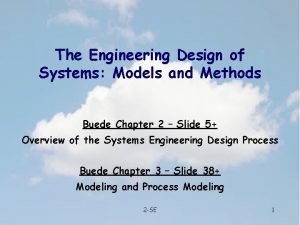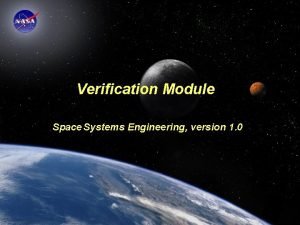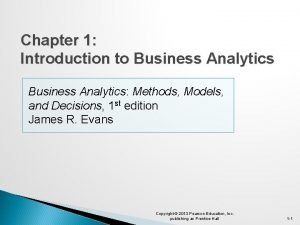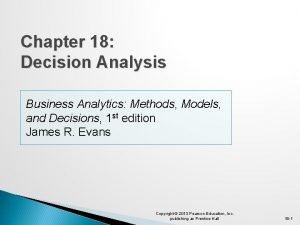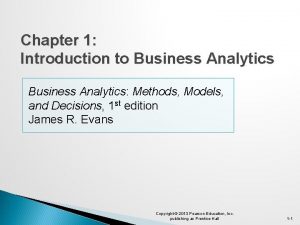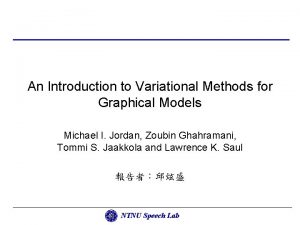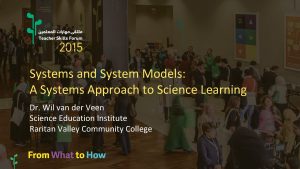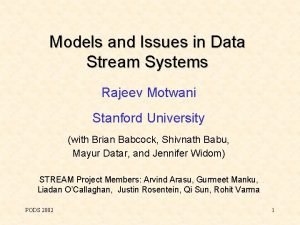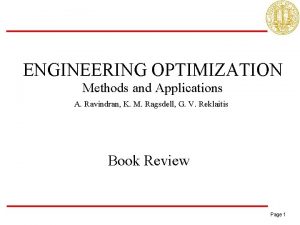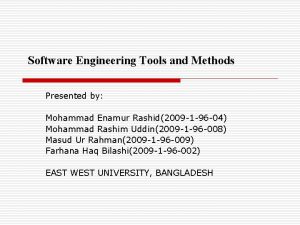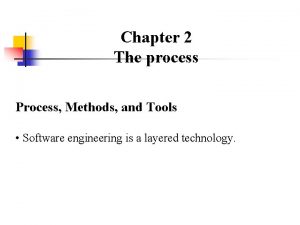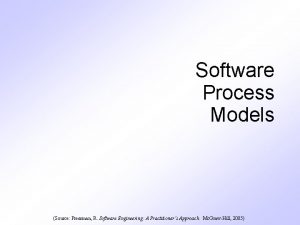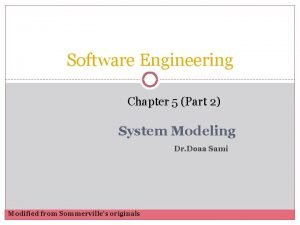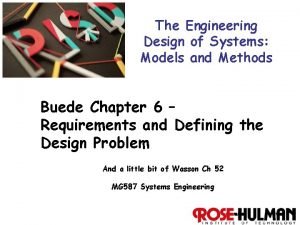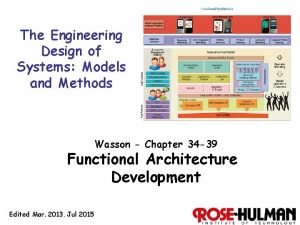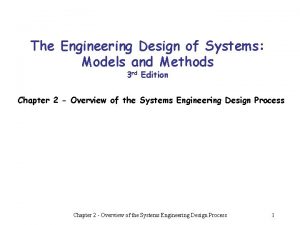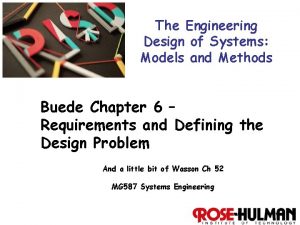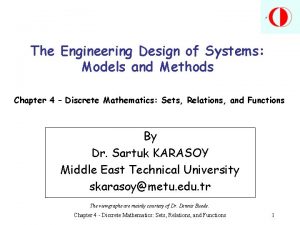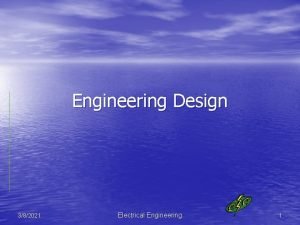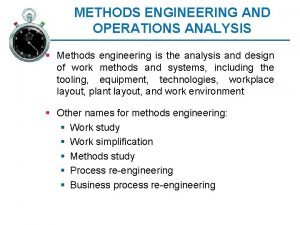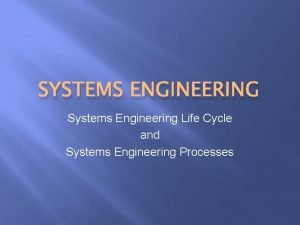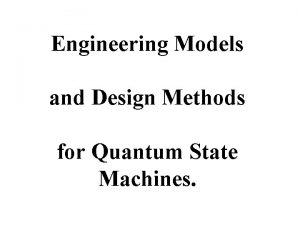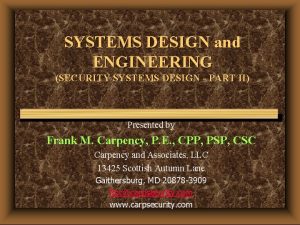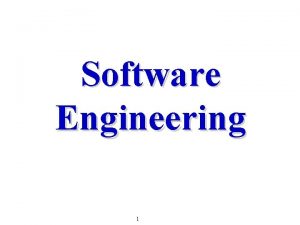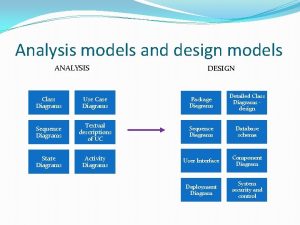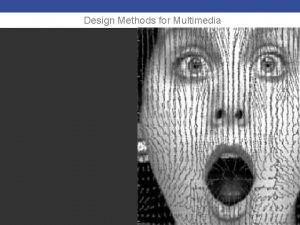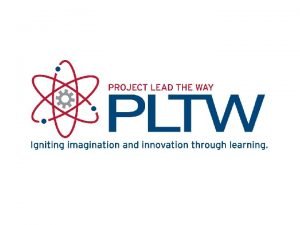The Engineering Design of Systems Models and Methods




















- Slides: 20

The Engineering Design of Systems: Models and Methods 3 rd Edition Chapter 11 – Integration and Qualification Chapter 11 - Integration and Qualification 1

• • Definitions Integration is the process of assembling any system from its components. Components would be assembled from their configuration items (CIs). Qualification is the process of verifying and validating the system design and then obtaining the stakeholders’ acceptance of the design – Verification is the determination that the system was built right. Verification by the tech team. – Validation determines that the right system was built. Typically validation by the client / customer. • Like Tommy Sparks in the Iron Man Movie by Marvel. He is demonstrating his military weapon system, as part of validation process to the military clients. Chapter 11 - Integration and Qualification 2

Conceptual Verification, Validity Requirements Validation Validity Operational Concept and Stakeholders’ Acceptance Requirements Stakeholders’ Needs System Requirements Design Validity Element Specs Acceptability Operational Validity System Delivered Developmental Verification Segment Specs Component Specs CI Specs Elements Delivered Segments Delivered Components Delivered CIs Delivered Systems Engineering SE Vee Design Engineering Time Chapter 11 - Integration and Qualification 3

Major Integration Functions for Component Integration Chapter 11 - Integration and Qualification 4

Logic Diagram for Subsystem Integration Chapter 11 - Integration and Qualification 5

Top Down Integration • Integration begins with a major or top-level module. • All modules called from the top-level module are simulated by “stubs” (shell or model replica). • Once the top-level module is qualified, actual modules replace the stubs until the entire system has been qualified. • This is most useful for systems using large amounts of COTS components. Phase Integration: Integration is done from the top down to the lowest level; one peel of the onion at a time. Incremental Integration: Integration is done for a specific module from top to bottom; one slice of the system at a time. Advantage • Early demonstration of the system is allowed. • Representation of the test cases is easier. • More productive if major flaws occur toward the top of system. Disadvantage • Stubs have to be developed. • Representation of test cases in the stubs may be difficult. • Observation of test output may be artificial and difficult. • This requires a hierarchical system architecture. Chapter 11 - Integration and Qualification 6

Bottom-up Integration • Integration begins with the elementary pieces (or CIs) of the system. • After each CI is tested, components comprising multiple CIs are tested. • This process continues until the entire system is assembled and tested. • This is the traditional systems engineering integration approach. Phase Integration: At any point in the integration, all of the subsystems are at the same stage of integration testing. Incremental Integration: proceeds one slice of the system at a time. Advantage • It is easier to detect flaws in the tiniest pieces of the system. • Test conditions are easier to create. • Observation of the test results is easier. Disadvantage • System’s control structure cannot be tested until the end. • Major errors in the system design are typically not caught until the end. • System does not exist until the last integration test is completed. • This requires a hierarchical system architecture. Chapter 11 - Integration and Qualification 7

Bottom-up Integration Process Chapter 11 - Integration and Qualification 8

Big Bang Integration • Untested CIs are assembled and the combination is tested. • This is a commonly used, and it is a criticized approach. Advantage • Immediate feedback on the status of system elements is provided. • Little or no pretest planning is required. • Little or no training is required. Disadvantage • Source of errors is difficult to trace. • Many errors are never detected. Chapter 11 - Integration and Qualification 9

Failure Definitions • Failure: deviation in behavior between the system and its requirements. . • Error: a subset of the system state, which may lead to a failure. • Fault: defects in the system that can cause an error. Chapter 11 - Integration and Qualification 10

Barriers to Verification · “We can never be sure that the specifications are correct. ” · “No verification system can verify every correct program. ” · “We can never be certain that a verification system is correct. ” Chapter 11 - Integration and Qualification 11

Qualification Planning Functions • Plan the qualification process – Acceptance test – Validation test – Verification test • Plan the qualification approaches • Plan qualification activities • Plan specific tests Chapter 11 - Integration and Qualification 12

Plan the qualification process · · · · Review system objectives Identify qualification system objectives Identify pass/fail thresholds Define qualification operational concept Define qualification requirements Define qualification functional architecture Define qualification generic physical architecture Generate qualification coverage matrices (allocate requirements to functional architecture and functions to the generic physical architecture) · Identify risks and mitigation strategies · Create master qualification plan Chapter 11 - Integration and Qualification 13

Plan the qualification approaches · Define qualification resources and organizations (instantiated physical architecture) · Assign qualification activities to organizations · Allocate qualification activities to resources · Develop qualification schedules consistent with development schedule Chapter 11 - Integration and Qualification 14

Plan qualification activities · Develop detailed derived qualification requirements · Develop functional architectures for qualification components · Generate coverage matrices (allocate derived requirements to functional architectures and functions to physical architectures) · Write activity-level qualification plans for each qualification component · Assign qualification responsibilities Chapter 11 - Integration and Qualification 15

Plan specific tests · Identify required stimulation data for each activity · Create test scenarios/test cases. · Write test procedures · Write analysis procedures · Define test and analysis schedules Chapter 11 - Integration and Qualification 16

Process for Developing the Qualification System Chapter 11 - Integration and Qualification 17

Qualification Methods Table 11. 3 Chapter 11 - Integration and Qualification 18

Testing Methods Table 11. 4 Chapter 11 - Integration and Qualification 19

Black & White Box Testing Table 11. 6 Chapter 11 - Integration and Qualification 20
 The engineering design of systems: models and methods
The engineering design of systems: models and methods Dicapine
Dicapine Elegant systems
Elegant systems Systems engineering verification methods
Systems engineering verification methods Modals and semi modals difference
Modals and semi modals difference Business analytics methods models and decisions
Business analytics methods models and decisions Decision tree business analytics
Decision tree business analytics Scope of business analytics
Scope of business analytics Flair furniture company linear programming
Flair furniture company linear programming Engineering systems design 2
Engineering systems design 2 An introduction to variational methods for graphical models
An introduction to variational methods for graphical models Metal coping fpd
Metal coping fpd Systems and system models
Systems and system models Models and issues in data stream systems
Models and issues in data stream systems Engineering optimization methods and applications
Engineering optimization methods and applications Software engineering tools and methods
Software engineering tools and methods Process methods and tools in software engineering
Process methods and tools in software engineering Software and systems integration facility
Software and systems integration facility Software engineering process models
Software engineering process models System modeling in software engineering
System modeling in software engineering Ock
Ock
